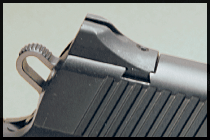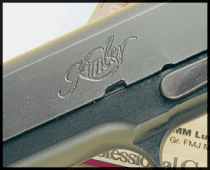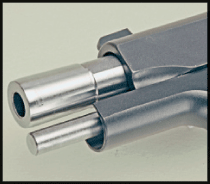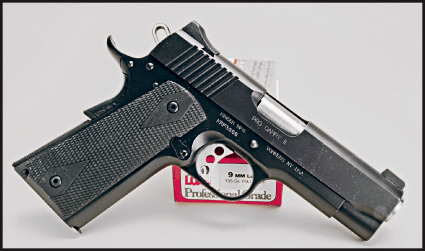Everybody knows that 1911 pistols are .45ACPs. The grand old gun was the product of John Browning’s ideas, run through the pragmatic screen of judgment used by Colt engineers and army ordnance officers. The result is a 1911 pistol that has become a term in the American shooter’s lexicon and a part of American history. In more recent times, many 1911-style pistols have been made by a host of American makers. Carried every day by thousands of ordinary people, those pistols are the first, and sometimes last, line of defense against criminal attack. The overwhelming majority uses the original .45ACP cartridge. The gun and its ammo are guarding America today, just as they have been doing for almost a century. The 1911s are .45s because that’s the natural order of things.
 But if that is true, why did Colt and the many modern makers chamber the gun for other cartridges? Why do they make 1911 pistols in that much-cursed, and much used, 9mm? First, understand that the 1911 is of sound design that could be adapted to a number of cartridges. Colt has made 1911s of one style or another in .38 Super, .22LR, 9mm, .30 Luger, .38 Special, .38 Super, 10mm, .40, and 9x23mm. Wildcatters have come up with other cartridges, some of them sensible but the majority not so sensible. All of this is mechanically possible because of the way the pistol was put together. The difficulty of using the 1911 platform is usually in developing a magazine that will present the cartridge at a workable orientation to the feed ramp, but it can be done. Sometimes, the procedure of making the old gun in a new caliber means using a round that is much shorter in overall length. That is the case with the 9mm, which Colt first put in a 9mm pistol in the 1950s. At this point in time, there were persistent rumors that the 9mm was going to be the new service cartridge. It took more than 30 years, but it eventually happened.
But if that is true, why did Colt and the many modern makers chamber the gun for other cartridges? Why do they make 1911 pistols in that much-cursed, and much used, 9mm? First, understand that the 1911 is of sound design that could be adapted to a number of cartridges. Colt has made 1911s of one style or another in .38 Super, .22LR, 9mm, .30 Luger, .38 Special, .38 Super, 10mm, .40, and 9x23mm. Wildcatters have come up with other cartridges, some of them sensible but the majority not so sensible. All of this is mechanically possible because of the way the pistol was put together. The difficulty of using the 1911 platform is usually in developing a magazine that will present the cartridge at a workable orientation to the feed ramp, but it can be done. Sometimes, the procedure of making the old gun in a new caliber means using a round that is much shorter in overall length. That is the case with the 9mm, which Colt first put in a 9mm pistol in the 1950s. At this point in time, there were persistent rumors that the 9mm was going to be the new service cartridge. It took more than 30 years, but it eventually happened.
Colt used a special magazine with a filler block in the rear to make it happen. Several other makers have also chambered their 1911 pistols for the European-standard 9mm and they have used various styles of magazines.
Advertisement — Continue Reading Below
So it can be done, but why would anyone want to do it? For almost any need, the 9mm is inferior to the .45, which is particularly true in the terminal ballistic sense. Designed in the early part of the 20th century to be a fight-stopper, the .45 is still doing that in the early 21st century.
America never warmed up to the 9mm until after WWII, although bring-back 9mm pistols from WWI were well known. The ammo makers loaded 9mm ammo for these guns, but American gunmakers didn’t produce a 9mm pistol until the 1950s. It is true that the 9mm exploded in popularity in the 70s and 80s, but the reason for that is because that the 9mm is small enough to fit in the high capacity magazine of a pistol that most shooters can manage. On-tap capacity caused a great many shooters to choose a 9mm pistol over a .45. Most of them should have known better. The 1911 pistol does not adapt well to the 9mm cartridge, because it wastes space in the magazine and in the slide travel. All of this brings us back to the original question: Why would anyone want a 1911 chambered for the 9mm?
 There are several plausible explanations. One of them centers on the cost of a box of ammo in .45ACP as opposed to the cost of 9mm. You can still find imported pistol ammo of good quality and the difference in price between 9mm and .45 is often substantial. It is also possible to find foreign 9mm when you can’t find .45. Further, the price of top quality 9mm against comparable .45ACP favors the smaller round. Even for a handloader, the cost of components affords a measurable saving, since it takes less powder to send a 9mm slug spiraling down range. If your goal is to develop basic shooting skill with a 1911 pistol, it is cheaper to do so if the gun shoots less expensive ammo. Simply put, you can shoot more for the same money.
There are several plausible explanations. One of them centers on the cost of a box of ammo in .45ACP as opposed to the cost of 9mm. You can still find imported pistol ammo of good quality and the difference in price between 9mm and .45 is often substantial. It is also possible to find foreign 9mm when you can’t find .45. Further, the price of top quality 9mm against comparable .45ACP favors the smaller round. Even for a handloader, the cost of components affords a measurable saving, since it takes less powder to send a 9mm slug spiraling down range. If your goal is to develop basic shooting skill with a 1911 pistol, it is cheaper to do so if the gun shoots less expensive ammo. Simply put, you can shoot more for the same money.
Advertisement — Continue Reading Below
In an all-steel 1911 9mm pistol, there is much less felt recoil than with a comparable .45. That carries over to a comparison of matching 9s and .45s with lightweight receivers. Savvy shooting instructors like to remove as many variables as possible in the learning process. It makes sense to use a pistol that doesn’t recoil to the degree that it distracts the shooter while they are trying to learn the hard skills of aligning a pair of sights and pressing a trigger. For an advanced shooter who is working hard to develop speed and accuracy, long and intense practice sessions are necessary. Toward the end of such sessions, fatigue begins to set in, and anything that keeps you focused on the basics is welcome. A little less recoil can be a big help. The 9mm 1911s make a lot of sense in these specialized roles. The goal is to make every element of pistol shooting a habit (grip, stance, breathing, trigger control) so that the mind is free to concentrate on aligning the sights. It should be obvious that aligning the sights of a 9mm 1911 is no different than aligning those of a .45.
 To illustrate my point, I obtained a Kimber Pro Carry II in 9mm. A brand-new pistol made from machined components, the Pro Carry II is a 1911-style gun with the easy to use short slide and barrel. It is a bushingless system that has a 4-inch barrel. The receiver is steel and remains the full-length type. Grips are businesslike hard rubber. It shoots very well with all of the aforementioned low recoil virtues. I have also determined that the pistol is accurate enough to please all but the advanced bull’s-eye shooters who are after the 50-yard X-ring, which measures 1.70 inches. It is a good gun that performs exactly as billed, delivering shot after shot with near robotic regularity. This is a very good 9mm pistol that any shooter should be pleased to own.
To illustrate my point, I obtained a Kimber Pro Carry II in 9mm. A brand-new pistol made from machined components, the Pro Carry II is a 1911-style gun with the easy to use short slide and barrel. It is a bushingless system that has a 4-inch barrel. The receiver is steel and remains the full-length type. Grips are businesslike hard rubber. It shoots very well with all of the aforementioned low recoil virtues. I have also determined that the pistol is accurate enough to please all but the advanced bull’s-eye shooters who are after the 50-yard X-ring, which measures 1.70 inches. It is a good gun that performs exactly as billed, delivering shot after shot with near robotic regularity. This is a very good 9mm pistol that any shooter should be pleased to own.
Although its performance supports every point that I have made in this article, I would still have chosen the .45 in the same configuration. That’s because I believe the .45 is a superior fight-stopping cartridge. But since there is also a demand for 9mms, Kimber will be happy to sell you one of these and I guarantee you will get your money’s worth. The 9mm 1911s make some sense, particularly when you are one of those guys who has access to a mountain of 9mm ammo with which to practice.
Advertisement — Continue Reading Below
For more information contact: www.kimberamerica.com
























